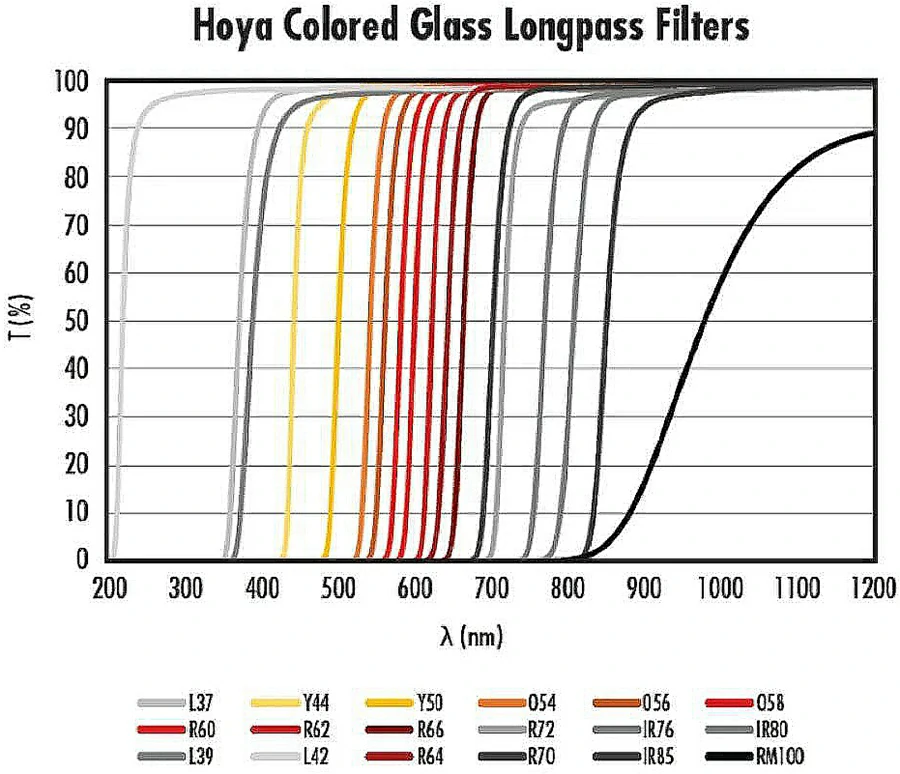
Introduction to Optical Filters
Optical filters are essential components in modern optical systems, enabling precise wavelength control. By selectively transmitting, reflecting, or absorbing light, they enhance performance in applications like spectroscopy, imaging, and laser technology.
Types of Optical Filters
Optical filters for spectral filtering include:
- Bandpass Filters: Transmit a specific wavelength range while blocking others.
- Wideband: Cover broader ranges (tens to hundreds of nanometers), ideal for color enhancement or general spectral selection.
- Narrowband: Feature narrow bandwidths (a few nanometers), critical for high-precision applications like fluorescence detection or laser systems.
- Longpass Filters: Transmit wavelengths above a cut-off, used in fluorescence microscopy or phototherapy.
- Shortpass Filters: Transmit wavelengths below a cut-off, common in IR cut-off applications for cameras.
Key Applications
Our optical filters serve diverse industries:
- Fluorescence Detection: Bandpass filters for fluorescence isolate excitation or emission wavelengths, enhancing signal clarity in biomedical analysis.
- Laser Technology: Narrowband filters protect lenses and isolate weak signals in laser ranging or LiDAR.
- Machine Vision: Filters like BP870 enhance contrast for defect detection or barcode reading.
- Environmental Monitoring: Filters (e.g., NBP870) detect specific gas or water quality spectra.
- Astronomy: Narrowband filters (e.g., H-α at 656.3nm) enable observation of celestial features.
Critical Performance Parameters
Filter selection hinges on:
- Center Wavelength (CWL) Accuracy: Essential for precision applications (±0.5nm or better).
–
Narrowband Filters: Require narrow bandwidths (FWHM) and high optical density (OD5+) to maximize signal-to-noise ratio.
- Transmittance: High peak transmittance (>90%) ensures strong signal output.
- Cut-off Steepness: Sharp transitions improve wavelength separation.
- Environmental Durability: Filters must withstand temperature, humidity, and laser-induced damage.
Filter Selection Guide
Choosing the right filter involves:
- Define Application Goals: Identify whether you need signal isolation, interference blocking, or specific lighting effects.
- Assess Parameters: Prioritize CWL accuracy, bandwidth, OD, and transmittance based on application needs.
- Match Light Source and Detector: Align filter specifications with source emission and detector response curves.
- Review Specifications: Check CWL, bandwidth, OD, cut-off steepness, and material properties.
- Consider Environmental Factors: Ensure durability for operating conditions like temperature or humidity.
- Balance Cost and Performance: Opt for cost-effective solutions without compromising critical requirements.
- Consult Experts: Work with our team for tailored solutions or complex applications.
Why Choose Our Optical Filters?
As a leading supplier, we offer:
- High-Precision Filters: Narrowband filters for spectroscopy and imaging with superior accuracy and durability.
- Custom and Stock Solutions: From IR cut-off to fluorescence filter sets, tailored to your needs.
- Competitive Quality: Matching global standards at cost-effective prices, ensuring reliable performance.


